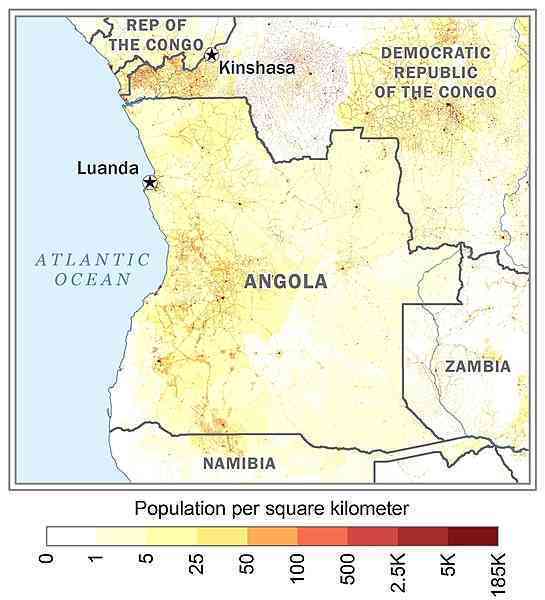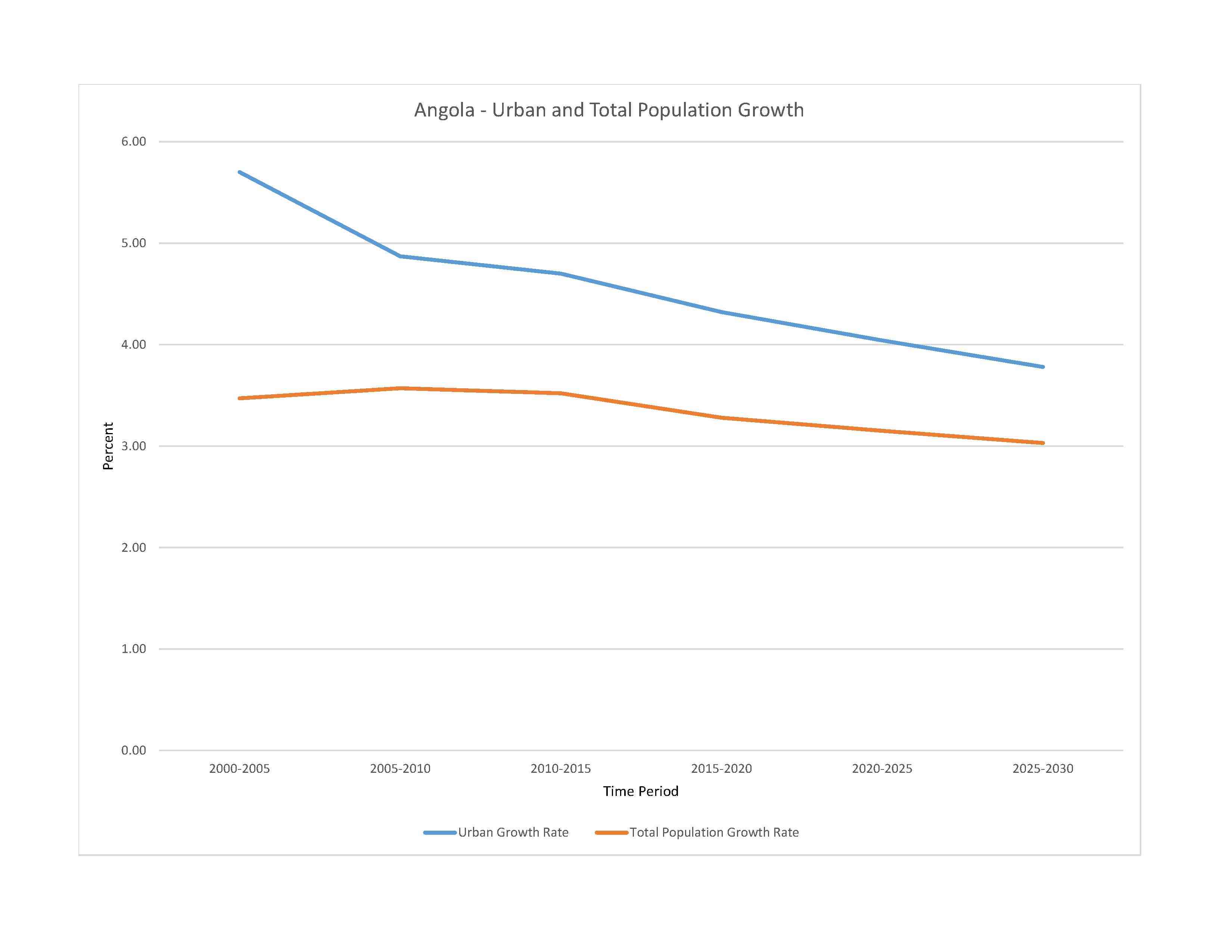
35,981,281 (2023 est.)
noun: Angolan(s)
adjective: Angolan
Ovimbundu 37%, Kimbundu 25%, Bakongo 13%, Mestico (mixed European and native African) 2%, European 1%, other 22%
Portuguese 71.2% (official), Umbundu 23%, Kikongo 8.2%, Kimbundu 7.8%, Chokwe 6.5%, Nhaneca 3.4%, Nganguela 3.1%, Fiote 2.4%, Kwanhama 2.3%, Muhumbi 2.1%, Luvale 1%, other 3.6%; note - data represent most widely spoken languages; shares sum to more than 100% because some respondents gave more than one answer on the census (2014 est.)
Roman Catholic 41.1%, Protestant 38.1%, other 8.6%, none 12.3% (2014 est.)
More than two decades after the end of Angola's 27-year civil war, the country still faces a variety of socioeconomic problems, including poverty, high maternal and child mortality, and illiteracy. Despite the country's rapid post-war economic growth based on oil production, about 30 percent of Angolans live below the poverty line and unemployment is widespread, especially among the large young-adult population. Only about 70% of the population is literate, and the rate drops to around 60% for women. The youthful population - about 48% are under the age of 15 as of 2022 - is expected to continue growing rapidly with a fertility rate of more than 5 children per woman and a low rate of contraceptive use. Fewer than half of women deliver their babies with the assistance of trained health care personnel, which contributes to Angola's high maternal mortality rate.
Of the estimated 550,000 Angolans who fled their homeland during its civil war, most have returned home since 2002. In 2012, the UN assessed that conditions in Angola had been stable for several years and invoked a cessation of refugee status for Angolans. Following the cessation clause, some of those still in exile returned home voluntarily through UN repatriation programs, and others integrated into host countries.
0-14 years: 47.18% (male 8,503,242/female 8,473,889)
15-64 years: 50.49% (male 8,730,015/female 9,435,581)
65 years and over: 2.33% (2023 est.) (male 350,059/female 488,495)
total dependency ratio: 91.5
youth dependency ratio: 86.5
elderly dependency ratio: 5
potential support ratio: 20.1 (2021 est.)
total: 16.2 years (2023 est.)
male: 15.7 years
female: 16.7 years
3.34% (2023 est.)
41.4 births/1,000 population (2023 est.)
7.8 deaths/1,000 population (2023 est.)
-0.2 migrant(s)/1,000 population (2023 est.)
most people live in the western half of the country; urban areas account for the highest concentrations of people, particularly the capital of Luanda as shown in this 
urban population: 68.7% of total population (2023)
rate of urbanization: 4.04% annual rate of change (2020-25 est.)

9.292 million LUANDA (capital), 959,000 Lubango, 905,000 Cabinda, 809,000 Benguela, 783,000 Malanje (2023)
at birth: 1.03 male(s)/female
0-14 years: 1 male(s)/female
15-64 years: 0.93 male(s)/female
65 years and over: 0.72 male(s)/female
total population: 0.96 male(s)/female (2023 est.)
19.4 years (2015/16 est.)
note: data represents median age at first birth among women 20-49
222 deaths/100,000 live births (2020 est.)
total: 57.2 deaths/1,000 live births (2023 est.)
male: 62.4 deaths/1,000 live births
female: 51.9 deaths/1,000 live births
total population: 62.5 years (2023 est.)
male: 60.4 years
female: 64.7 years
5.76 children born/woman (2023 est.)
2.84 (2023 est.)
13.7% (2015/16)
improved: urban: 81.3% of population
rural: 36.5% of population
total: 66.5% of population
unimproved: urban: 18.7% of population
rural: 63.5% of population
total: 33.5% of population (2020 est.)
2.9% of GDP (2020)
0.21 physicians/1,000 population (2018)
improved: urban: 93.7% of population
rural: 30.3% of population
total: 72.7% of population
unimproved: urban: 6.3% of population
rural: 69.7% of population
total: 27.3% of population (2020 est.)
degree of risk: very high (2023)
food or waterborne diseases: bacterial and protozoal diarrhea, hepatitis A, typhoid fever
vectorborne diseases: dengue fever, malaria
water contact diseases: schistosomiasis
animal contact diseases: rabies
8.2% (2016)
total: 5.84 liters of pure alcohol (2019 est.)
beer: 3.78 liters of pure alcohol (2019 est.)
wine: 0.72 liters of pure alcohol (2019 est.)
spirits: 1.27 liters of pure alcohol (2019 est.)
other alcohols: 0.08 liters of pure alcohol (2019 est.)
19% (2015/16)
55.7% (2023 est.)
women married by age 15: 7.9%
women married by age 18: 30.3%
men married by age 18: 6% (2016 est.)
2.4% of GDP (2020 est.)
definition: age 15 and over can read and write
total population: 71.1%
male: 82.6%
female: 62.4% (2015)
NOTE: The information regarding Angola on this page is re-published from the 2024 World Fact Book of the United States Central Intelligence Agency and other sources. No claims are made regarding the accuracy of Angola 2024 information contained here. All suggestions for corrections of any errors about Angola 2024 should be addressed to the CIA or the source cited on each page.
This page was last modified 04 May 24, Copyright © 2024 ITA all rights reserved.